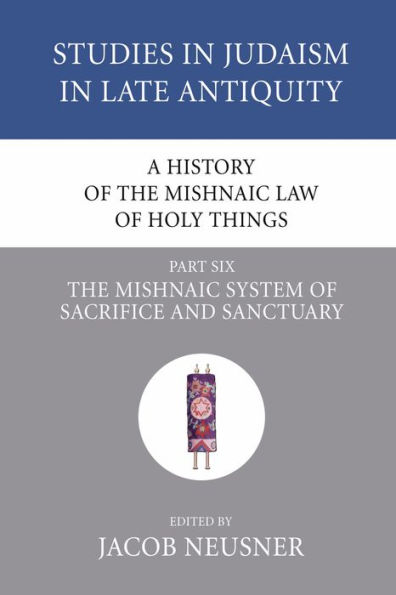A History of the Mishnaic Law of Holy Things, Part 6
The history of Jews from the period of the Second Temple to the rise of Islam.
From 'A History of the Mishnaic Law of Appointed Times, Part 1'
This volume introduces the sources of Judaism in late antiquity to scholars in adjacent fields, such as the study of the Old and New Testaments, Ancient History, the ancient Near East, and the history of religion. In two volumes, leading American, Israeli, and European specialists in the history, literature, theology, and archaeology of Judaism offer factual answers to the two questions that the study of any religion in ancient times must raise. The first is, what are the sources — written and in material culture — that inform us about that religion? The second is, how have we to understand those sources in reconstructing the history of various Judaic systems in antiquity. The chapters set forth in simple statements, intelligible to non-specialists, the facts which the sources provide. Because of the nature of the subject and acute interest in it, the specialists also raise some questions particular to the study of Judaism, dealing with its historical relationship with nascent Christianity in New Testament times. The work forms the starting point for the study of all the principal questions concerning Judaism in late antiquity and sets forth the most current, critical results of scholarship.
1030551454
From 'A History of the Mishnaic Law of Appointed Times, Part 1'
This volume introduces the sources of Judaism in late antiquity to scholars in adjacent fields, such as the study of the Old and New Testaments, Ancient History, the ancient Near East, and the history of religion. In two volumes, leading American, Israeli, and European specialists in the history, literature, theology, and archaeology of Judaism offer factual answers to the two questions that the study of any religion in ancient times must raise. The first is, what are the sources — written and in material culture — that inform us about that religion? The second is, how have we to understand those sources in reconstructing the history of various Judaic systems in antiquity. The chapters set forth in simple statements, intelligible to non-specialists, the facts which the sources provide. Because of the nature of the subject and acute interest in it, the specialists also raise some questions particular to the study of Judaism, dealing with its historical relationship with nascent Christianity in New Testament times. The work forms the starting point for the study of all the principal questions concerning Judaism in late antiquity and sets forth the most current, critical results of scholarship.
A History of the Mishnaic Law of Holy Things, Part 6
The history of Jews from the period of the Second Temple to the rise of Islam.
From 'A History of the Mishnaic Law of Appointed Times, Part 1'
This volume introduces the sources of Judaism in late antiquity to scholars in adjacent fields, such as the study of the Old and New Testaments, Ancient History, the ancient Near East, and the history of religion. In two volumes, leading American, Israeli, and European specialists in the history, literature, theology, and archaeology of Judaism offer factual answers to the two questions that the study of any religion in ancient times must raise. The first is, what are the sources — written and in material culture — that inform us about that religion? The second is, how have we to understand those sources in reconstructing the history of various Judaic systems in antiquity. The chapters set forth in simple statements, intelligible to non-specialists, the facts which the sources provide. Because of the nature of the subject and acute interest in it, the specialists also raise some questions particular to the study of Judaism, dealing with its historical relationship with nascent Christianity in New Testament times. The work forms the starting point for the study of all the principal questions concerning Judaism in late antiquity and sets forth the most current, critical results of scholarship.
From 'A History of the Mishnaic Law of Appointed Times, Part 1'
This volume introduces the sources of Judaism in late antiquity to scholars in adjacent fields, such as the study of the Old and New Testaments, Ancient History, the ancient Near East, and the history of religion. In two volumes, leading American, Israeli, and European specialists in the history, literature, theology, and archaeology of Judaism offer factual answers to the two questions that the study of any religion in ancient times must raise. The first is, what are the sources — written and in material culture — that inform us about that religion? The second is, how have we to understand those sources in reconstructing the history of various Judaic systems in antiquity. The chapters set forth in simple statements, intelligible to non-specialists, the facts which the sources provide. Because of the nature of the subject and acute interest in it, the specialists also raise some questions particular to the study of Judaism, dealing with its historical relationship with nascent Christianity in New Testament times. The work forms the starting point for the study of all the principal questions concerning Judaism in late antiquity and sets forth the most current, critical results of scholarship.
42.0
In Stock
5
1

A History of the Mishnaic Law of Holy Things, Part 6
334
A History of the Mishnaic Law of Holy Things, Part 6
334Paperback
$42.00
42.0
In Stock

Product Details
| ISBN-13: | 9781556353543 |
|---|---|
| Publisher: | Wipf & Stock Publishers |
| Publication date: | 04/01/2007 |
| Series: | Studies in Judaism in Late Antiquity , #28 |
| Pages: | 334 |
| Product dimensions: | 7.19(w) x 8.94(h) x 0.77(d) |
About the Author
From the B&N Reads Blog
